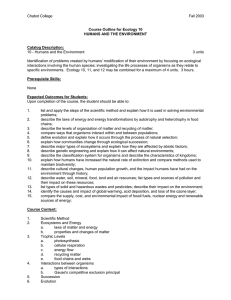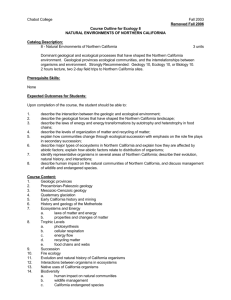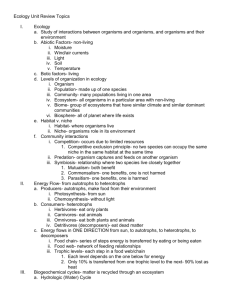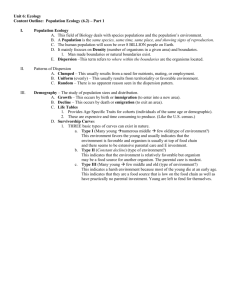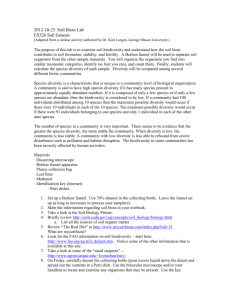Humans and the Environment with Laboratory
advertisement
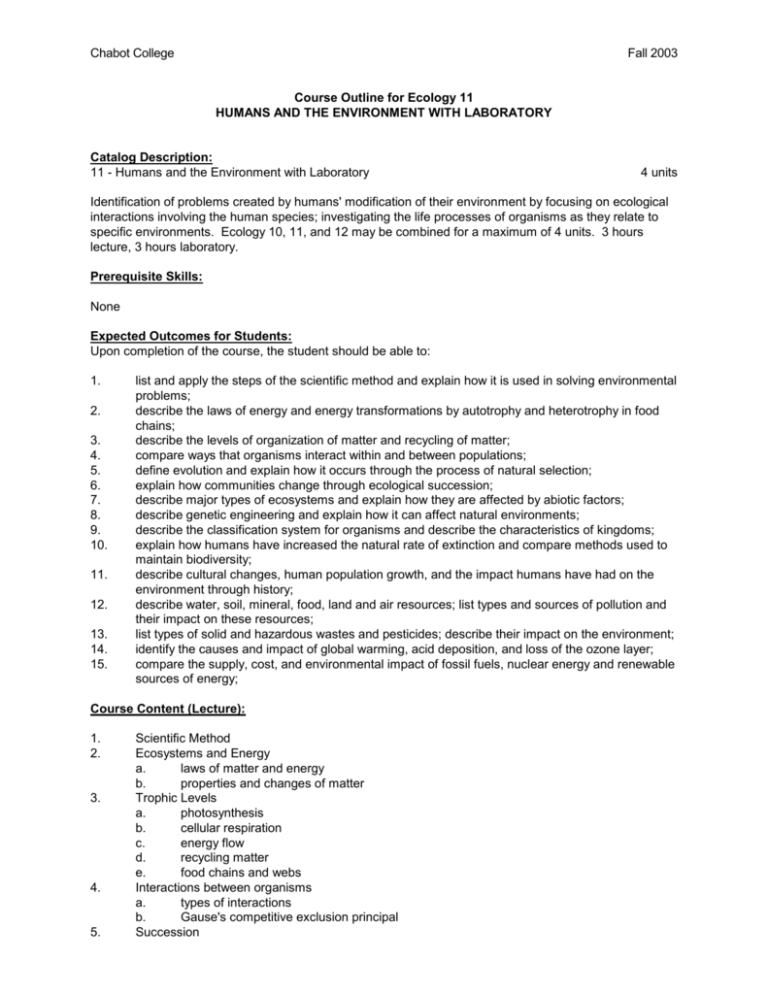
Chabot College Fall 2003 Course Outline for Ecology 11 HUMANS AND THE ENVIRONMENT WITH LABORATORY Catalog Description: 11 - Humans and the Environment with Laboratory 4 units Identification of problems created by humans' modification of their environment by focusing on ecological interactions involving the human species; investigating the life processes of organisms as they relate to specific environments. Ecology 10, 11, and 12 may be combined for a maximum of 4 units. 3 hours lecture, 3 hours laboratory. Prerequisite Skills: None Expected Outcomes for Students: Upon completion of the course, the student should be able to: 1. 2. 3. 4. 5. 6. 7. 8. 9. 10. 11. 12. 13. 14. 15. list and apply the steps of the scientific method and explain how it is used in solving environmental problems; describe the laws of energy and energy transformations by autotrophy and heterotrophy in food chains; describe the levels of organization of matter and recycling of matter; compare ways that organisms interact within and between populations; define evolution and explain how it occurs through the process of natural selection; explain how communities change through ecological succession; describe major types of ecosystems and explain how they are affected by abiotic factors; describe genetic engineering and explain how it can affect natural environments; describe the classification system for organisms and describe the characteristics of kingdoms; explain how humans have increased the natural rate of extinction and compare methods used to maintain biodiversity; describe cultural changes, human population growth, and the impact humans have had on the environment through history; describe water, soil, mineral, food, land and air resources; list types and sources of pollution and their impact on these resources; list types of solid and hazardous wastes and pesticides; describe their impact on the environment; identify the causes and impact of global warming, acid deposition, and loss of the ozone layer; compare the supply, cost, and environmental impact of fossil fuels, nuclear energy and renewable sources of energy; Course Content (Lecture): 1. 2. 3. 4. 5. Scientific Method Ecosystems and Energy a. laws of matter and energy b. properties and changes of matter Trophic Levels a. photosynthesis b. cellular respiration c. energy flow d. recycling matter e. food chains and webs Interactions between organisms a. types of interactions b. Gause's competitive exclusion principal Succession Chabot College Course Outline for Ecology 11, page 2 February 1994 6. 7. 8. 9. 10. 11. 12. 13. 14. 15. 16. 17. 18. 19. 20. 21. 22. 23. Evolution Natural Selection and Speciation Systematics a. naming and classification b. kingdoms Biodiversity a. endangered species b. wildlife management Physical Environment a. abiotic factors b. biogeochemical cycles Major Ecosystems Human Population a. population ecology b. human population growth c. population control Water Resources a. California water problems b. pollution c. sewage treatment Soil Resources a. characteristics of soil b. soil organisms c. loss of soil and pollution Mineral Resources a. types and uses of mineral resources b. 1872 Mining Act c. conservation of minerals Land Resources a. land use b. timber issues c. public lands management Food Resources a. origins and growth of agriculture b. world agriculture systems c. first and second Green Revolutions d. sustainable agriculture and organic farming Pesticides a. types and uses of pesticides b. problems caused by pesticides c. Integrated Pest Management Solid and Hazardous Wastes a. sources of waste b. waste disposal c. types of hazardous waste d. Love Canal and Superfund Global change of the atmosphere a. global warming-Kyoto Protocol b. acid deposition c. loss of ozone layer Fossil Fuels Nuclear Energy Renewable Energy Chabot College Course Outline for Ecology 11, page 3 February 1994 Course Content (Laboratory): 1. 2. 3. 4. 5. 6. 7. 8. 9. 10. 11. 12. 13. 14. 15. 16. 17. Scientific Method Communities Natural Selection Systematics Hayward Shoreline field Trip Nitrogen Fixation Ecological Transect Across California: Oakland Museum Field Trip Populations Water Analysis Soil Analysis Minerals Food Resources Integrated Pest Management Landfills Global Warming Davis Street Waste Management Field Trip Energy Methods of Presentation: 1. Lecture and discussion. 2. Multimedia presentations. 3. Field trips 4. Research paper/term project Typical Assignments and Methods of Evaluating Student Progress: 1. Typical Assignments a. Soil Chemistry and Organisms Lab Review b. Oakland Museum field trip report c. Term paper Suggested topics 1) should the Endangered Species Act be amended to include economic factors? 2) Why is tropical deforestation a global problem? 3) Examine the issue of debt for nature swaps. Are they effective in preserving natural resources? 2. Methods of Evaluating Student Progress a. Laboratory reviews b. Quizzes c. Midterm examinations d. Laboratory practical examinations e. Final examination f. Research project/term paper Textbook(s) (Typical): Environment, Raven and Berg, Saunders Publishers, 3rd edition, 2001 Lab Manual and Study Guide, D. Howell, 2001 Special Student Materials: None kk Revised: 9/24/02
